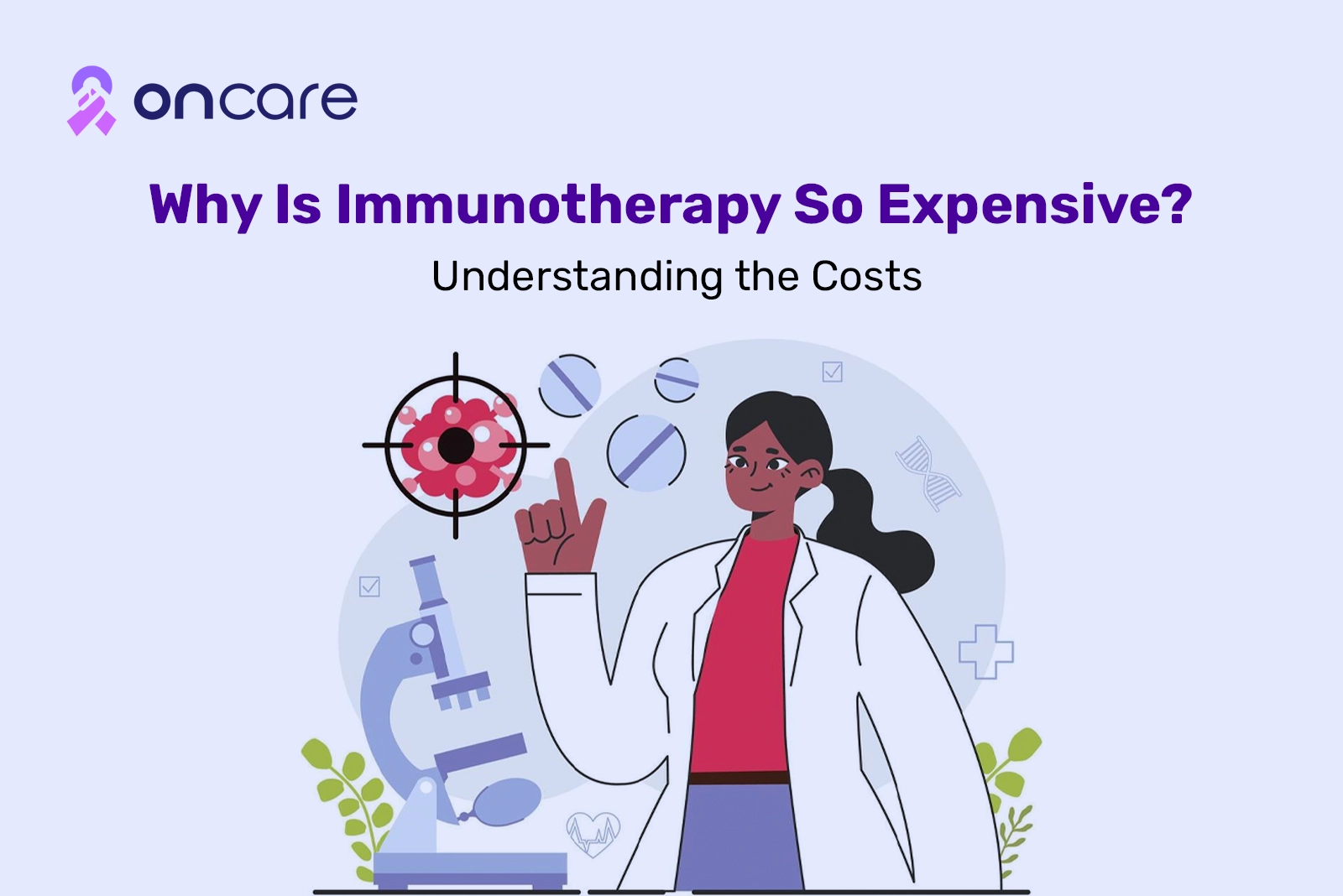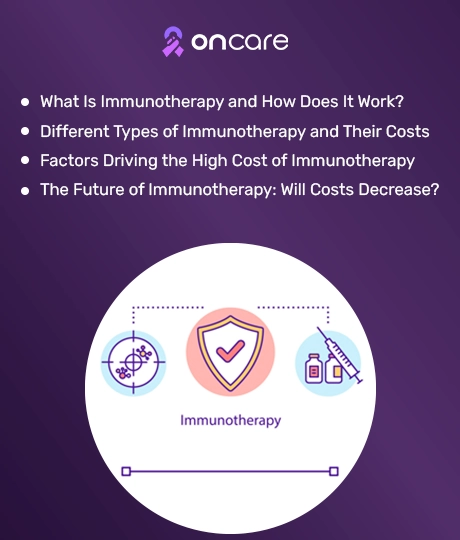Why Is Immunotherapy So Expensive? Understanding the Costs

Immunotherapy has revolutionized cancer treatment by targeting and destroying cancer cells by using the body's immune system. However, despite its effectiveness, the high cost remains a significant concern for many patients. The expenses stem from extensive research and development, complex manufacturing processes, and regulatory requirements. Factors like patent protections, limited competition, and the need for specialized medical infrastructure further contribute to its price. While ongoing advancements and policy changes may help reduce costs in the future, affordability remains a challenge. At Oncare, we provide effective yet affordable immunotherapy solutions, guiding patients through treatment costs and support options. Our goal is to make advanced cancer care more accessible and less overwhelming.
What Is Immunotherapy and How Does It Work?
Immunotherapy is a groundbreaking cancer treatment that enhances the body's immune system to recognize and attack cancer cells more effectively. Unlike chemotherapy or radiation, which directly target cancer cells, immunotherapy stimulates or modifies the immune response to fight the disease. It includes various approaches, such as immune checkpoint inhibitors, monoclonal antibodies, cancer vaccines, and CAR-T cell therapy. These treatments help the immune system detect cancer cells that might otherwise evade natural defense mechanisms.
The way immunotherapy works depends on the type of treatment used. For example, checkpoint inhibitors block proteins that prevent immune cells from attacking cancer, allowing them to work more aggressively. On the other hand, CAR-T cell therapy involves modifying a patient's T cells in a lab to enhance their ability to target cancer cells. While immunotherapy has shown promising results, especially for certain cancers like melanoma and lung cancer, its effectiveness varies by individual. Oncologists continue to refine these treatments to improve patient outcomes and expand their use across different cancer types. At Oncare, we customize immunotherapy plans based on each patient's needs, ensuring they receive the most suitable treatment. With accessible options and financial support, we strive to make immunotherapy more affordable and stress-free.

Different Types of Immunotherapy and Their Costs
The average cost of immunotherapy ranges from 8 lakh to 1.6 crore per year, depending on the treatment type. Costs vary due to research, development, and administration complexities. At Oncare, we help patients navigate their immunotherapy options while offering enhanced financial support.
Below are the main types of immunotherapy and their average costs.
Immune Checkpoint Inhibitors
These drugs block proteins like PD-1, PD-L1, and CTLA-4, which cancer cells use to evade immune detection. The immune system can better recognize and destroy cancer cells by inhibiting these checkpoints. Treatments such as Pembrolizumab (Keytruda) and Nivolumab (Opdivo) have shown great success in treating cancers like melanoma and lung cancer. However, they are costly, with prices ranging from 8 lakh to 12 lakh per dose, leading to total treatment expenses that can exceed 80 lakh annually.
Monoclonal Antibodies
Monoclonal antibodies are lab-engineered proteins designed to target specific molecules on cancer cells, blocking growth signals or marking them for immune attack. Some are conjugated with toxins or radioactive elements to enhance their effectiveness. Examples include Trastuzumab (Herceptin) for breast cancer and Rituximab (Rituxan) for lymphoma. These treatments generally cost between 4 lakh and 12 lakh per infusion, with the total expense depending on the length and frequency of therapy.
CAR-T Cell Therapy
CAR-T cell therapy is an advanced treatment that involves extracting a patient’s T cells, modifying them in a lab to enhance their ability to target cancer cells, and reinfusing them into the body. This highly personalized approach has demonstrated exceptional success in blood cancers such as leukemia and lymphoma. However, due to its complex manufacturing and individualized nature, CAR-T therapy is one of the most expensive cancer treatments, costing between 50 lakhs to 1 crore per treatment, excluding hospitalization and post-treatment care.
Cancer Vaccines
Cancer vaccines stimulate the immune system to recognize and attack cancer cells. They can be preventive, such as the HPV and Hepatitis B vaccines, which reduce the risk of virus-related cancers, or therapeutic, like Sipuleucel-T (Provenge) for prostate cancer. Preventive vaccines are relatively affordable, costing between 12,000 and 40,000, while therapeutic vaccines can be much more expensive, often ranging from 75 lakh to 1 crore per treatment course.
Cytokine Therapy
Cytokines are immune system proteins that help regulate immune responses. In cancer treatment, cytokine therapy uses interleukins and interferons to boost immune activity against tumors. Although largely replaced by newer immunotherapies, it remains a viable option for some cancers. Drugs like Interleukin-2 (Aldesleukin) and Interferon-alpha can cost between 1.5 lakh and 6.5 lakh per dose, with total costs varying based on dosage and treatment duration.
Oncolytic Virus Therapy
Oncolytic virus therapy uses genetically modified viruses to infect and kill cancer cells while stimulating an immune response. This emerging approach is still in its early stages, with limited availability. The most well-known example is Talimogene Laherparepvec (T-VEC), which is used for melanoma treatment. Given its specialized nature, oncolytic virus therapy typically costs between 50 lakh and 65 lakh per treatment cycle.
Factors Driving the High Cost of Immunotherapy
The high cost of immunotherapy is influenced by multiple factors, from research expenses to complex production and regulatory hurdles. Below are the key reasons why these treatments remain expensive:
Research and Development (R&D) Costs
Developing immunotherapy drugs requires years of research, extensive clinical trials, and cutting-edge technology. The costs of laboratory studies, preclinical testing, and multi-phase human trials add up significantly. Many experimental drugs fail during trials, increasing the financial burden on successful treatments.
Complex Manufacturing Process
Unlike traditional chemotherapy, many immunotherapy treatments, such as CAR-T cell therapy, involve personalized medicine. This requires collecting and modifying a patient’s immune cells in specialized labs, leading to higher production costs. The intricate nature of biotechnology-based treatments further limits large-scale manufacturing, keeping prices high.
Patent Protection and Market Exclusivity
Pharmaceutical companies hold patents that prevent generic versions of immunotherapy drugs from entering the market for years. This exclusivity allows manufacturers to set high prices without competition. Even after patents expire, the complexity of producing biosimilars delays patient cost reduction.
Administration and Treatment Costs
Immunotherapy often requires specialized infusion centers, trained medical staff, and continuous patient monitoring. Managing side effects and ensuring treatment efficacy leads to frequent hospital visits and added healthcare expenses. At Oncare, we offer advanced treatment facilities and expert care for side effect management at customized financial plans designed to fit patients’ budgetary needs.
Regulatory and Approval Challenges
Regulatory bodies like the FDA and EMA require rigorous testing before approving new immunotherapy drugs. The lengthy approval process includes safety evaluations, efficacy trials, and post-market surveillance, all adding to the final cost. Stricter regulations in different countries also affect pricing and accessibility.
Insurance and Financial Barriers
Many insurance plans do not fully cover immunotherapy, leaving patients with high out-of-pocket costs. Copayments, deductibles, and limited reimbursement policies make access challenging. While financial assistance programs exist, navigating them can be complex, further delaying treatment for those in need.
The Future of Immunotherapy: Will Costs Decrease?
The high cost of immunotherapy remains a significant challenge for patients, healthcare providers, and policymakers. However, as advancements in medical research, technology, and drug manufacturing continue, there is hope that costs will gradually decline. Efforts are being made to develop biosimilars—similar versions of existing immunotherapy drugs—which could introduce competition and lower prices. Additionally, improvements in manufacturing processes, such as automation and streamlined production, may help reduce the cost of producing complex therapies like CAR-T cell therapy.
Government policies and healthcare reforms play a crucial role in reducing immunotherapy costs. Regulatory bodies are working towards faster approvals of affordable alternatives, while insurance providers are expanding coverage to improve accessibility. Clinical trials are also exploring new, cost-effective immunotherapy combinations. However, widespread affordability may take time due to patents, research investments, and infrastructure limitations. Until then, financial assistance programs and patient support services remain essential in helping individuals access life-saving immunotherapy treatments.
Conclusion
Immunotherapy has brought groundbreaking advancements in cancer care, but its high cost remains a significant hurdle for many patients. Factors like research expenses, complex production, and regulatory constraints contribute to its pricing, with affordability still challenging despite ongoing efforts to reduce costs. As new developments emerge, staying informed about financial aid programs, insurance coverage, and alternative treatment options becomes crucial. Understanding these cost factors can empower patients to make informed choices about their care. At Oncare, we are committed to supporting patients beyond just treatment by helping them navigate the financial challenges of immunotherapy. From exploring potential assistance programs to guiding available resources, we strive to bridge the gap between care and affordability, ensuring that cost never becomes a barrier to life-saving treatment.
Frequently Asked Questions (FAQs)
Immunotherapy's high cost is attributed to several factors, including extensive research and development, complex manufacturing processes, and the need for personalised treatments. Additionally, regulatory approvals and market exclusivity contribute to the overall expense.
The cost of immunotherapy varies depending on the specific treatment and cancer type. On average, treatments can exceed ₹80 lakh per patient annually. For instance, specific CAR-T cell therapies may cost between ₹2.9 crore and ₹4.1 crore per treatment.
Insurance coverage for immunotherapy varies by provider and policy. While many insurance plans cover FDA-approved immunotherapy treatments, patients often face significant out-of-pocket expenses due to copayments, deductibles, and coverage limitations.
Yes, several financial assistance programs are available to help patients manage the costs of immunotherapy. These include manufacturer-sponsored assistance, non-profit organizations, and government programs designed to aid eligible patients in covering treatment expenses.
Ongoing advancements such as the development of biosimilars, improved manufacturing techniques, and policy reforms aim to reduce immunotherapy costs. Expanding insurance coverage and increasing competition in the market may also help make these treatments more accessible. However, significant price reductions could take time due to research investments and regulatory approvals.